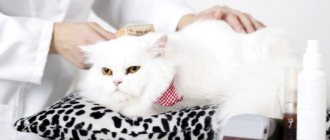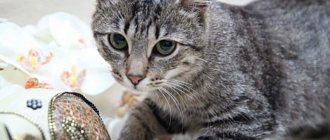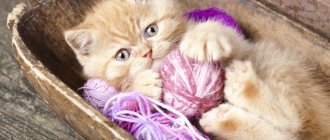Every person who decides to get a pet needs to be prepared for various manifestations of the character of the new animal. Cats have a particularly specific disposition and character. If a cat is abused or inconvenienced, it may leave the house and live on the street - for most felines it is unacceptable to live in a house where no one loves it.
A cat lives on its own - a very fair and accurate definition of its character.
Even the most domestic cat is capable of doing incredible things. The cat owner needs to have a lot of patience to get used to the new pet and its character.
Cat character
If a person decides to get a cat, he must understand that he will bring more than just a fluffy ball of fur into his home. A cat is a character, devotion and boundless love for its owner. In principle, a cat is no less devoted to its owner than a dog, but the dog is simply a devoted friend who is ready to sacrifice himself for the sake of the owner. The cat, despite its love and devotion to its owner, loves itself very much. The cat will never let itself be offended, and for any fault of the owner it is ready to take revenge on him and show that she is dissatisfied. Cats, like people, are quite social, and by living next to a person, a cat acquires skills that simplify its future life.
Pet owners often say that their cat is very smart or, on the contrary, stupid. These statements are not about the animal's mental abilities; a smart cat means that the animal is interested in others and has the ability to learn. An incorrect approach to a cat or rough approaches to raising a pet can lead to negative results. For a cat to grow up smart and become a full-fledged member of the family, it needs to be treated appropriately; it is the owner who is responsible for the future character of the pet. In its behavior and habits, the cat will resemble its owner, and to successfully raise an animal, the training process must begin from an early age. It is necessary to make it clear to the pet from the very beginning that he is very loved in his new home, but at the same time he must behave very decently and obey his owners.
Under favorable conditions and the right approach, cats are easy to train, but there is one negative point - the more a cat is socialized in society, the fewer natural instincts it has. For example, domestic cats play well with artificial mice and gradually forget that there are live mice that cats must hunt. Domestic purebred cats are so accustomed to living in the house and playing with artificial toys that the hunting instinct in them has practically died out. A purebred cat almost always shows no interest in small rodents and birds; she does not understand that this is prey and can be eaten.
The most common mistake in the education process is punishment; cats most often do not understand why they are being punished, so if they are often punished for reasons unknown to them, then they become angry and even dangerous. The owner must always remember that his every glance and action towards the cat will return back to the owner according to the principle of a boomerang. It is necessary to show the animal what is wrong or what does not suit the owner; simply scolding or using physical force will not give positive results.
Angora
Angora cats delight not only with their snow-white fur, but also with their optimism. They are ready to play and purr all day long and are affectionate. They are able to imitate human speech, emitting an expressive purr. They often get bored with the desire to be close and rub against the owner.
If you decide to get a kitten, do not try to take the baby. Wait until your baby is 3 months old. At this age, the character traits of the four-legged furry are already determined.
Communication of a cat with its relatives
As noted above, cats do not need to live with their relatives; of course, warm feelings may arise between animals from time to time, but they pass very quickly. Cats need their relatives only during the mating season or during the period of raising offspring, when the mother cat needs help caring for the babies.
There is a certain hierarchy in the places where a cat lives - the cat considers the dining room and resting place to be the house of the first order. Having explored these places, the animal quickly gets used to them and considers these places to be its property. The cat protects these places from any encroachment by other animals. If a cat has a very developed instinct of ownership, then it will be ready to fight just to drive away a competitor. The space around the first-order house is not so important for cats; around their houses, every animal can meet its relatives, but more often than not they do not communicate and try to ignore other cats and male cats.
During festivities, cats mark their own territory with special urine, which has an unpleasant and pungent odor. Any cat that enters this territory evokes sympathy from the male and he is ready to enter into a relationship with her. The period of walking for males is the most difficult period both for the owners of the cat and for the male himself. The owner has to endure the unpleasant smell and screams of the cat. For a cat, the period of walking carries many dangers because... he is forced to engage in real battles with other rivals for the right to communicate with the cat.
During the period of domestication of cats, their original instincts fade away and new habits appear, taken from the people who surround the animal. If a new cat gets into the first-order house of its relative, then the owner of the house will try by all means to drive out the uninvited guest. In such a situation, the cat that lives in the house will behave very aggressively towards the guest and will try to show the cat that this is her home and there is no place for other cats. The guest most often tries to find some corner or hill where he can hide and quietly observe the events taking place.
If two cats are brought into a new room where neither of them has been before, they will begin to study the situation and will not pay attention to each other. Only when the entire territory has been explored, the cats may want to communicate, or maybe each of them will simply find their place and pretend that they are alone in this room. In the first stages of acquaintance, when both cats are on equal terms with each other, they go through a certain acquaintance ritual:
- curiosity - each is interested in studying its relative and they carefully examine each other;
- the sense of smell increases, each of them tries to catch all the odors emanating from a relative;
- cats are at a distant distance from each other, they try to get closer to each other, stretching their necks towards each other and warily sniffing their relatives;
- If the first acquaintance was successful, then the next stage will be sniffing the most important places - the sides, back of the head and the place under the tail.
The further development of the relationship depends on the individual characteristics of each cat; most often, the more experienced and stronger cat begins to put pressure on the second and tries to subordinate him to his power. The second one in such a situation tries to escape from the meeting place as soon as possible.
It is a common belief that only cats from the same litter can live in the same territory for a long time and not conflict with each other. In all other cases, you need to understand that the more residents in one room, the more conflicts will arise between them. Even old cats who live together for a long time can conflict and fight. They have no concept of getting along with their relatives; relations will constantly move from the stage of reconciliation to the stage of war. Constant clarification of relationships between cats who live in the same room is explained by the fact that cats have a very independent character, it is very difficult for them to get along in the same territory with other cats and generally share their space with someone else. Already from birth, kittens are determined to have a leader in the litter; it is very easy to recognize him among babies - the leader always tries to take the most comfortable position near the mother or at the bowl. Such a kitten is not afraid to get into fights with its brothers and sisters, and is also the instigator of all conflicts in the litter. Such a character in the future will make a real fighter out of a kitten who will fight for his property and defend his space.
It is worth noting that there is no specific hierarchy between cats, and they do not choose their leaders, just one cat has the personal characteristics of a leader, and he displays them to the fullest.
Any attacks on the leader end in battle and intimidation of other cats. Most cats occupy the middle level, so to speak, they are not aggressive, they calmly treat their relatives and try not to get into fights without a reason. The middle link is the most common; cats that live in such formations get used to each other, they get food together, help each other wash themselves and clean their fur. The lowest layer is the cats who are afraid of the cats around them and cannot socialize. They do not approach the food bowl; at the sight of stronger felines, frightened cats run away and look for a safe place. If frightened cats live together for a while and understand that they are not in danger, they will be able to settle in normally and live next door to other cats.
It has been noticed that the younger the cat, the easier it is for him to get to know other cats, this is explained by the curiosity that is so inherent in young cats. Curious young individuals are ready to explore the world around them and get to know their relatives. Some cats become really close over time - they can share food, play and sleep together. It is not uncommon for an adult cat, most often neutered, to teach a young cat the principles of life. True, friendship most often does not last long; soon one of the friends begins to be jealous of the other cats and the friendship comes to an end. If you bring a young cat or male cat into a house where an adult cat already lives, the owners will most often be faced with several options for the development of events. The old cat begins to mark the territory and show with all his appearance that he is the master here, the old cat’s character deteriorates significantly, he begins to be jealous of the owners of the new pet and will take revenge on everyone. An old cat can intimidate a young cat and turn him into an angry and frightened creature who cannot live in the same room with another cat.
Cats have a very developed maternal instinct; they are ready to protect their children even if they can already fend for themselves. Each kitten is very important for its mother; the cat teaches all her children the tricks of cat life, does not allow fights between children and protects them from adult relatives. If two mother cats live in the same territory, then their maternal instinct extends to all kittens - their own and others. If one of the cats dies, the second takes in the orphaned kittens and tries to feed them all. When the kittens grow up a little, the cat begins to show aggression towards them, this is due to the fact that the cat’s milk disappears, and the kittens hurt their mother with their sharp teeth.
Black cats
And what the black cat has suffered because of its dark fur coat. He is blamed for all the troubles, especially if he crosses the road. It is a symbol of bad luck and witchcraft. Angry and vindictive - this is what they say about the character of these felines, and it is completely in vain. The perception of an animal is strongly influenced by a person’s negative attitude towards dark color, which personifies negative character traits.
In reality, when crossing the road, a black cat removes all the negativity in front of the passer-by, taking it upon itself. They can safely be called the most powerful healers and protectors of their owners. They are able to absorb negative energy, relieve stress and pain, improve well-being, and warn of an unholy guest, since they sense people’s vibrations very well. A black cat can really take revenge, but only on someone who offended his owner, to whom he is incredibly loyal.
Their temperament is unpredictable and contradictory. They are able to endure any challenge due to their high vitality. They endure the consequences of physical injuries more easily than representatives of other colors. This is most likely because black tends to absorb heat and energy.
Black cats are like panthers - mysterious and graceful, with excellent hunting sense, capable of standing up for themselves, charming predators. They are active and proactive, love communication, including with other animals, and do not tolerate loneliness well. They are very friendly despite the rumors circulating about them, but can be stubborn. Sometimes they like to take long walks on their own and go long distances from home, proving their independence.
Communication between cats and other animals
In the cat's worldview, all animals that come across a cat's life receive the status of either a pursuer or prey. Scientists have long proven that a cat considers almost all animals it meets as its relatives. Only after finding out by smell that the animal is weaker than her, she understands that this animal is prey or, conversely, the cat is prey. The older the cat, the easier it is for her to distinguish her prey from her pursuer. When a cat lives in a natural environment, it is easier and faster for her to understand who is friend or foe in the yard. Country cats almost never show interest in poultry. They can show their maternal instinct not only on kittens, but also on babies of other animals - piglets, kids, etc. A cat calmly reacts to large animals - cows, pigs, she understands perfectly well that she is not in any danger from them. Cats develop friendly relations with some neighbors in the yard, and in winter the cat can bask in utility rooms along with other animals.
Little kittens, due to their curiosity and ignorance, can even mistake hamsters and parrots for their relatives. A kitten can play with a hamster, but if the baby’s instincts awaken, the little friend may be in serious trouble. But this does not always happen; there are cats that can live peacefully with a white rat, even if it moves around the apartment without obstacles.
The complex and contradictory relationship between a cat and a dog deserves special attention. In most cases, living in the same house with a cat and a dog is peaceful and without quarrels. But there are other cases when quarrels and showdowns begin between neighbors. Enmity between two animals occurs due to the manifestation of the instincts of each of them. Dog owners influence this relationship; some owners set dogs against street cats. If dog owners do not set their pets against street cats, then a completely friendly relationship can develop between a dog and a cat. There are times when a cat meets its four-legged friend in the park or simply sits at the entrance and waits for the dog to be taken for a walk. A running cat makes the dog want to rush after and catch up with the fleeing object. Even if a dog catches up with a cat, it almost never harms it. Cats are quicker to navigate dangerous situations and can do something that will greatly surprise or even frighten the dog. Having overtaken a cat, the dog most often simply barks at it, but does not dare to attack.
If you take a puppy and a kitten into your home at the same time, then they will grow up to be true and devoted friends who will rarely argue and will mostly exist peacefully with each other.
An old dog can also easily get along with a young cat - in this case, the dog’s maternal instinct awakens, and the kitten perfectly replaces the puppy. Dogs can generally replace a kitten’s mother and take full care of the baby. The kitten perceives the dog as its mother and does not feel any danger from it, realizing that the baby can do whatever he wants, he begins to indulge in every possible way and anger the dog. The kitten often takes tasty food from the dog’s bowl, scratches the dog’s nose, bites the dog’s tail painfully, etc. The dog in such a situation is patient and humbly waits until the baby grows up and stops being a bully. If the kitten is confident in his big friend, he can calmly fall asleep on the dog's stomach, knowing that he is completely safe and under strict protection. In principle, with a strong desire, even adult dogs and cats can be made friends, it will just take more time and effort.
Over time, the cat stops paying attention to the dog’s barking and clumsy movements, and the dog eventually stops hunting the cat. Cats are often more liked by their owners than dogs. Cats are allowed to sleep in the owner's bed, their food always tastes better - this and much more hurts the dogs, because in the relationship between pets there is always a competitive moment, and when the cat receives more attention from the owner, the dog begins to play pranks and attract the owner. During such periods, apathy on the part of the dog, bad mood and even refusal to eat are possible. Cats love to tease dogs; it happens that a cat starts playing with a dog, winds it up, cheers it up, and then just quietly leaves the angry dog. At such a time, the dog is ready to do anything just to play with the cat.
Difficulty in care
Every cat requires grooming, but some breeds require more or less attention. Difficulty in content can both depress and delight - consider your desires and capabilities.
Cats that do not require special care
If you don’t want to spend your evenings combing wool or thinking about your pet’s menu, pay attention to the following breeds:
Abyssinian cat
Short fur and sparse shedding
Bombay cat
Cat for lovers of black clothes
Egyptian Mau
Easy to care and maintain
Cornish Rex
Enough to feed and pet
Oriental cat
Almost no shedding
Siamese cat
Suitable for even the laziest owner
This is an abbreviated list, but the easiest cats to care for are short-haired cats with no quirks in appearance.
Long-haired cats often shed and require careful grooming, while hairless cats get cold and sweat. Pets with short hair are an excellent choice for a busy owner.
Difficult breeds to keep
Are you a passionate cat lover and ready to devote a considerable amount of time to caring for your pet? Then take a closer look at these breeds:
Don Sphynx
In winter it will never leave the battery
Canadian Sphynx
Freezes in the cold, sweats in the heat
Maine Coon
A big cat has more fur
Persian cat
Thick fur sheds heavily
Ragdoll
Lazy and fluffy
Scottish lop-eared
Curled ears need to be cleaned regularly.
Sphinxes are cold cats that want constant warmth and care. The Persian cat is complex due to its record length of fur, which constantly gets tangled into tangles. In addition, Persians have a flat face, which can cause them to get sick often.
It is not easy to care for cats with unusual ears: Scottish Fold or American Curls. Also, all long-haired breeds can be considered difficult-to-care cats.
Communication between a person and a cat
Affectionate and sociable cats do not fall on us from heaven and do not become so on their own. It is we, the owners, who turn them into the most tender and devoted friends. How does this happen? Through idleness. It's hard to believe, but it is true. However, not all owners know how to devote their time to doing nothing. Anyone who is busy with all sorts of things from early morning until late evening and does not want to let his cat near him even at night simply does not give her the opportunity to show friendliness.
PETT ME!
If your cat does not come to you on her own, think about it: perhaps it seems to her that none of the people around her are ready to communicate with her. After all, the longer you sit at the computer keyboard, the less time you have to sit with your tailed pet in front of the TV screen. If you are constantly busy and this is repeated day after day, the animal will certainly feel deprived of the love of its owners. Try to pay at least a little attention to your cat, because quite often each family member thinks about the tailed beauty.
CAT'S PLACE IS ON HANDS
Don't move away from your cat, pet her often and pick her up. Take the example of children who, without thinking twice, run up to a kitten, grab it and pick it up, even if it is sleeping or busy playing. Then the child drags the animal, unceremoniously torn from the arms of Morpheus or an exciting game, to the other end of the room and at the same time rather awkwardly squeezes it in his hands. However, in reality, all this is not as terrible as it looks from the outside.
Kittens have been accustomed to this kind of treatment since childhood. Their own mother treats them much the same way. She picks up her offspring, tightly squeezing the kitten's scruff with her teeth, pulls them into the nest, and then carefully licks each one. We pet them instead, although newborn kittens are unlikely to yet understand these subtleties of handling.
WITHOUT EXCESSIVE DELICACY
Parents usually scold their children for such behavior. They think that such rough treatment could result in psychological trauma for the animal. But as a result, such owners only achieve that the cat, seeing their dissatisfaction, tries to avoid communicating with the child. Therefore, you should not deprive children of joy and forbid them to tinker with the cat. If we are not talking about truly cruel treatment and the cat does not try to escape from the child’s hands, it means that she is happy with the attention from him. If the cat wants to leave, the child is unlikely to be able to hold it by force. Thus, parents should intervene only in exceptional cases.
Hairless
Don Sphynx
Don Sphynxes are affectionate, non-aggressive, and playful. They have somewhat dog-like habits, while remaining unobtrusive and tactful.
Breed characteristics
- Hairless cover;
- medium sized body;
- big ears; expressive almond-shaped eyes;
- pronounced eyebrows and cheekbones;
- long graceful paws.
Canadian Sphynx
The Canadian Sphynx is the first recognized breed of hairless cat. All Sphynx cats are characterized by increased body temperature and the ability to tan. They become very attached to their owners. These creatures need constant communication. Canadians are very smart and learn new things easily. They are friendly with absolutely everyone and get along great with children.
Breed characteristics
- Hairless cover;
- dense muscular body;
- folds on the skin;
- the forelimbs are shorter than the hind limbs;
- large wide ears with rounded tips.
Petersburg Sphinx
Of all the types of sphinxes, the Petersburg, or Peterbald, is the most graceful. He looks more like an oriental cat than other sphinxes. The Peterbald is a companion cat; he does not like to walk on his own. Thanks to the presence of Siamese-Oriental cat breeds in the pedigree, the Peterbald is very active. His character retains all the traits characteristic of the ancestors of other breeds: lack of aggression, sociability and love.
Breed characteristics
- Hairless cover;
- thin, invisible undercoat;
- small wedge-shaped head with huge ears;
- blue or green eyes;
- long nose, straight profile.
Cat and man
A cat is an independent animal; cats never live in packs, and prefer a solitary existence rather than communicate with their relatives. But in nature, cats are forced to communicate with other animals, and living in houses, cats develop certain relationships not only with other animals, but also with humans. It depends on the person what kind of relationship will develop between him and his pet. Cats are capable of developing vigorous activity or spending their time in constant rest and sleep.
Scientists have conducted many experiments on the relationship between cats and humans and have come to some interesting conclusions. Firstly, a cat may behave atypically if it has done something wrong and is afraid of punishment. Secondly, a cat can beg its owner for a long time and persistently for a treat or some kind of tasty treat. Thirdly, over time, a cat acquires the same habits as its owner and can even behave in the same way as a person. Fourthly, a cat can set its own rules that a person must follow, for example, it will not eat food if it was thrown on the floor and not in a bowl.
Cats have excellent memory and excellent time orientation. The cat can go out into the hallway at the same time every day to meet its owner from work. It turns out that a cat can remember a certain chain of events and reproduce these actions in its memory. The entire environment in the house is also very important for a cat; if it has just been brought into the house, it will sniff every detail of the interior for a long time and carefully, and only after that it will begin to look for a place to rest and spend further time.
Most of all, cats like high furniture, where they can climb and hide, and from there they can see a large area of the room and it is convenient for the cat to monitor its space. Once a cat chooses a place to sleep, it is almost impossible to retrain it to another place. For example, if a pet decides that it is comfortable for him to sleep on a chair, then it will be very difficult for the owner to wean him from this place. As soon as a kitten is brought into the house, you need to decide what he can do and what he cannot do, if the owner is not satisfied with what the kitten is doing, you must immediately explain to him that this is not necessary, otherwise it will become a habit and then wean the matured pet it will be much more difficult. If you allow your cat to sleep in the bed from the very beginning, then it will be impossible to wean it off. All the habits that a kitten has had since childhood cannot be eradicated from an adult pet.
A cat is an intelligent animal, and naturally cats very quickly understand what can and cannot be done. If you pamper your pet a lot from childhood and allow him everything, then the kitten will grow up and decide that everything is allowed to him, naturally this will not end well. If a kitten is allowed to behave as he wants during childhood, then the owner will later reap the benefits of such upbringing. For example, if a cat gets used to sleeping with its owner, then when it is not allowed into the bedroom, it will bite and scratch its beloved owner and may even go to the toilet in the wrong place.
A cat must know the boundaries of what is permitted from the very moment it appears in the house; each upbringing is selected in accordance with the character of the cat. It is almost impossible to give any specific recommendations here. The only condition is that you cannot raise cats using force, you cannot force the animal, otherwise such upbringing will not bear any fruit. Education should be strict, but fair, the cat should feel that she is loved anyway.
Psychological portrait of a cat
Each cat has its own distinctive features associated not only with its breed, but also with its character and temperament. Of course, each cat walks on its own, but is always close to a person. Notices his mood and well-being. The presence of the owner will never leave her indifferent. Even a dozing cat never loses sight of you.
Probably, a cat’s devotion is not as noticeable as a dog’s, and she shows her emotions quite differently from other animals, so a person must be able to understand and appreciate her psychological qualities in order to get real pleasure from communicating with her.
- Cats experience severe stress from separation from their owner, sometimes this leads to their death.
- For cats there is no understanding of a leader, as, for example, for a dog.
- The cat has strong emotional ties with the owner and will never test his strength as a leader. Maybe for the same reason, physical punishment for her is not a signal for obedience or a prohibition.
- A cat, no matter where it lives, must have its own small territory, a corner where it can hide from others and relax. It is very important to organize such a space for your pet. Having their own, sole territory is one of the psychological characteristics of cats.
To develop a healthy psyche, kittens should not be taken from their mother before eight weeks of age. You need to take him in your arms for a short time, gently caress him, and lightly stroke him. This will give the future cat a feeling of security, confidence and at the same time a positive attitude towards the space around her.
The cat does not serve the owner, is not able to carry out his orders unquestioningly, but, nevertheless, it is vital for her to be near a person; at the genetic level, she needs communication with him, the care and affection of a person. This is a psychological need. She is more of a companion and partner in a person's life than an assistant and servant.
By understanding these simple features of cat psychology, you will be able to build the correct behavior of your pet.
White cats
White color is a symbol of purity and innocence. Such qualities are attributed to cats with light fur. It is believed that they are timid and vulnerable animals with the sweetest character - calm and kind. In most cases this is true. White cats are aristocratic, reverent and sensitive. They respond to their owners with the most tender affection and good manners for their kind attitude and good care. Very sensitive to people's moods. Despite their affection, white cats remain very delicate and are not intrusive.
Sometimes such love does not turn out well for them. It makes animals suspicious and suspicious of other people whom they fear. Internal anxiety negatively affects the nervous system of cats. In this state, they do not tolerate stress well and have difficulty adapting to new conditions.
As for white cats with different eyes, they differ from their ordinary counterparts in their complete unpredictability. The pet's character changes at such a speed that it is impossible to predict what will ultimately attract his curiosity and what actions he will take in the next moment. Such cats do not like the attention of strangers and loud scandals; they are very sensitive to the emotional mood of their owner.
Cat hunt
Kittens perceive hunting as a game, and only as they grow up, when the animal’s predator and hunter instincts awaken, does the game take on real meaning. From about 6 weeks, kittens begin to understand that hunting is more than just a game. First, the kids watch their mother hunt, and then they themselves become involved in this activity. At first, during a hunt, a kitten may be afraid of prey, but having matured a little, it will understand that it is stronger and smarter than its prey, then the fear will go away, and only instincts will remain. Cat hunting is a very interesting and exciting spectacle.
A predator can sit in a secluded place for a long time and not show any signs of life, and then suddenly appear near the prey and grab it at the first opportunity. The cat always rests on the ground with its hind paws, and grabs the prey with its front paws. In the very first throw, the cat bites through the cervical vertebrae of the prey; for most small rodents this bite will be fatal. After this, the cat begins to play with the prey, and it does not matter whether the prey is alive or not. Having played enough with the prey, the cat eats it. Often, a cat kills prey even if it is not hungry - thus, it simply satisfies its hunting instincts.
Why does a cat bring mice - the cat's hunting instincts
According to the cat, people know absolutely nothing about catching mice. And that is why her calling is to help us in this difficult matter. Cats are not greedy creatures. If a cat is full, it will definitely share its prey with others. Thus, individuals less successful in hunting are often treated to fellow animals who have achieved success in this. Sometimes, when cats live as one large family (for example, on farms where they all raise offspring together), they can observe an effective division of labor. If an independent cat with a clear passion for hunting suddenly stands out among other mothers, she is allowed to realize herself in this field. She can focus entirely on catching mice, thereby taking on the role of nurse, while the other cats take care of her offspring.
Bringing another half-strangled mouse into the flock, the hunter conducts a master class - showing her brothers how to catch and kill it more efficiently.
This is why cats bring trophies to their owners. This is how they demonstrate to us their professionalism, for which they expect a well-deserved reward, or at least worthy praise. And if suddenly the mouse shows dexterity and runs away, you should not stand still! You should immediately give chase. Well, at least that's what your cat thinks.
And in order not to offend her best feelings, don’t even try to squeal in horror: “Ugh! What kind of abomination is this?!” Show self-control. Accept this valuable gift and pretend that you are going to enjoy it. But don't get carried away. It is enough to take the mouse somewhere, pretending that you want to retire for a meal.
The main thing is not to throw away the trophy in front of the cat.
Cat and mouse
And today, some people still believe that a cat can be fed with anything and that such food will be quite acceptable for it. There are also those who think that a cat doesn’t need to be fed at all, because it can catch mice, which means it can find food for itself. However, not all so simple.
Such owners forget that a cat that has to do without human help has no reason to love people, not to mention the fact that a cat left unattended can quickly acquire fleas, intestinal parasites, chronic diseases and acute infections. This cat's life is unlikely to be long unless someone reports it to animal control. Such an attitude of owners towards their pets is considered as cruelty to animals and is criminally punishable.
Although cats are indeed much more independent than dogs, they do not always show their independence, but tench, in those cases when it justifies itself. For example, when it comes to hunting mice. However, you are very mistaken if you think that cats catch mice solely for food. There are many tailed gourmets who put the newly caught mouse aside and rush to the bowl filled with food. Their gaze seems to say: “Will you look after my mouse? I urgently need something to eat..."
When hungry, cats always happily return home to their bowl. It is difficult to say why the food seems to them tastier than mouse meat. Only one thing can be said with certainty: mice are not at all interested in pleasing your cat, while cat food manufacturers are trying to add as many flavoring additives as possible to make their products tastier and thereby increase sales. .
EDIBLE - INEDIBLE
Domestic cats kept in apartments generally do not have to deal with live mice, let alone eat them. Having seen a mouse, such a cat will not even touch it. After all, kittens learn what is edible and what is not in the first weeks of life. In the case of hunting mice, they follow the example of their mother. However, the offspring of a domestic cat are deprived of this experience and do not even realize that mice can be eaten.
IS A MOUSE A TROPHY OR A TREAT?
Mice are perceived completely differently by the offspring of a yard cat, who, at the first opportunity, brings them live mice and teaches them how to catch, kill and eat their prey. Kittens who have not learned this from their mother, when they grow up, can learn to catch mice themselves, but they never eat them, and in most cases they proudly bring them home as a trophy. The likelihood of a cat being poisoned by a mouse is extremely low. Much more often, cats die due to poisoned baits thrown at them by cruel neighbors. But if you feed your cat well, she is unlikely to touch a treat from a stranger.
Be that as it may, mouse meat contains everything that is necessary for a cat’s complete nutrition: proteins, fats, carbohydrates, ballast and other nutrients, some of which are absent in regular home food. Therefore, professional breeders prefer to feed their cats special food.
How a cat chooses a place for itself
It is worth noting that cats love to sleep; in total, cats spend about 2/3 of the time of their entire lives in a state of sleep and dozing. A cat's sleep and its duration depend on the age, season, health and sexual needs of the animal. Kittens and older cats sleep more than adults. In a dream, an animal can actively move; scientists have not yet established why this happens, so all that remains is to make guesses and assumptions.
The cat chooses a place to sleep very carefully, because it spends so much time in this state. Access to the sleeping area should be free, and at the same time, the place should be located so that no one disturbs the pet's sleep. A cat can change places to sleep if something doesn’t suit it in its current place. The difficulty is that the sleeping place must have a good view of the room, the cat must be confident in its safety. Often conflicts arise between the cat and the owner when the owner shows the pet the chosen place to sleep, but the cat does not want to sleep in this place and chooses another place that does not suit the owner.
There are certain principles that guide an animal when choosing a sleeping place:
- their favorite place is the owner’s lap; cats generally love to bask in their arms when they are stroked and scratched. If the cat owner does not mind the cat sleeping in the owner's bed, then this will be the best place to sleep. However, most experts do not recommend allowing pets to sleep in their owner's bed. No matter how much the owner of the animal takes care of the cleanliness and health of the cat, the bed is not a place for animals;
- not very brave and courageous individuals choose places on a hill, so that in case of danger they will have some advantage;
- cats are thermophilic, so they love to sleep near heaters, radiators and stoves. In the winter season, you need to carefully monitor your pet, make heating devices as safe as possible, or put them out of reach of your pet;
- Dark corners and inconspicuous places also appeal to cats. The main thing for a cat is a feeling of safety; if the cat knows that nothing threatens it, then it will have no need for hiding places;
- cats love various boxes and containers with a recess. Pets often sleep in crates or laundry baskets.
In order for your cat to lead an active lifestyle and be able to sleep peacefully, several recommendations should be followed. The cat must choose a place to sleep on its own; the more a person interferes with this choice, the more difficult it will be for the cat to get used to this place. In the place chosen by the cat, if it completely suits the owner, you need to lay a cover or rug. The rug needs to be cleaned periodically because... it quickly gets dirty with wool and litter from the tray. You can help in choosing a place to sleep by purchasing a special sleeping place.
Nowadays, a huge variety of houses and beds for sleeping are sold on the shelves of pet stores. You can buy a booth with an opening roof or just a mattress with sides; most often cats like such places and they sleep in them with pleasure. For a cat to sleep peacefully and soundly, one place is not enough. The pet should walk in the fresh air and receive adequate nutrition; if the cat receives everything it needs for normal functioning, then it will sleep soundly and be in a good mood.
Rex
Hyperactive representatives of the feline world do not sit still for a minute. Their pirouettes will leave no one indifferent. Like trapeze artists, they jump from one horizontal surface to another. Flexible and friendly. They have hypoallergenic wool, which looks like astrakhan fur. If danger arises, they are able to protect themselves and their owner. Fearless, but not aggressive.











